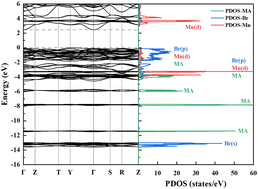A DFT study on CH3NH3MnBr3: a novel multiferroic organic–inorganic hybrid perovskite
Abstract
Nowadays, ferroelectric organic–inorganic hybrid perovskite represents a crucial issue since it exhibits a huge potential to enhance solar cell efficiency significantly. Furthermore, introducing magnetism into the polar organic–inorganic hybrid perovskites can open up new possibilities for designing novel multiferroic materials and expanding their practical applications. Here, we present a comprehensive investigation of the prototypical CH3NH3MnBr3 using first-principles calculations. Our findings suggest that this material is a promising organic–inorganic hybrid multiferroic, exhibiting ferroelectricity and G-type antiferromagnetism simultaneously. The estimate of the polarization for the orthorhombic phase is ∼22.11 μC cm−2. The contributions of the polar MA cations and MnBr3 inorganic framework to the polarization are disentangled to be around 32 and 68% for MA cations and the MnBr3 inorganic framework, respectively. The interplay between them is analyzed in terms of energy and electronic structure, suggesting possible routes for the transition between ferroelectric and antiferroelectric states and the polarization switching path.



 Please wait while we load your content...
Please wait while we load your content...